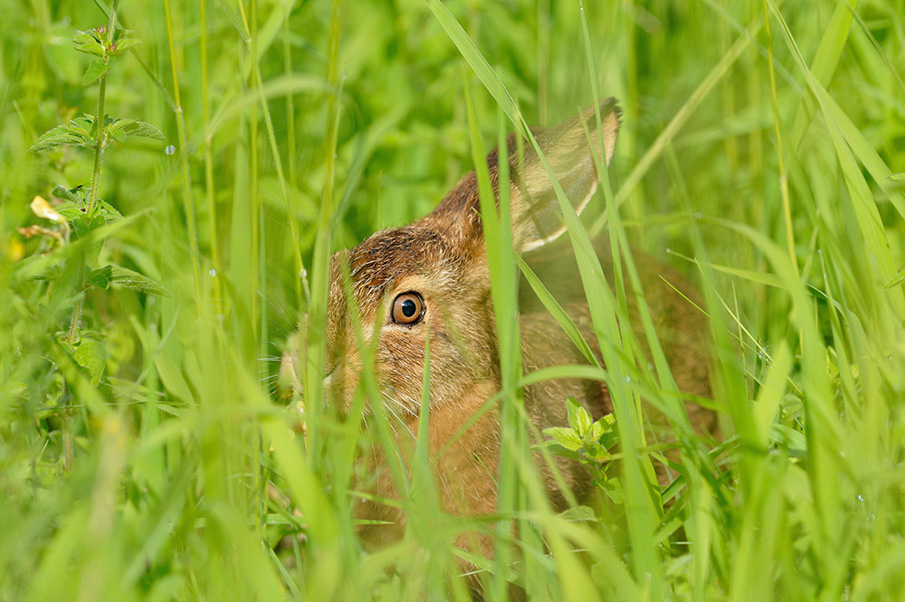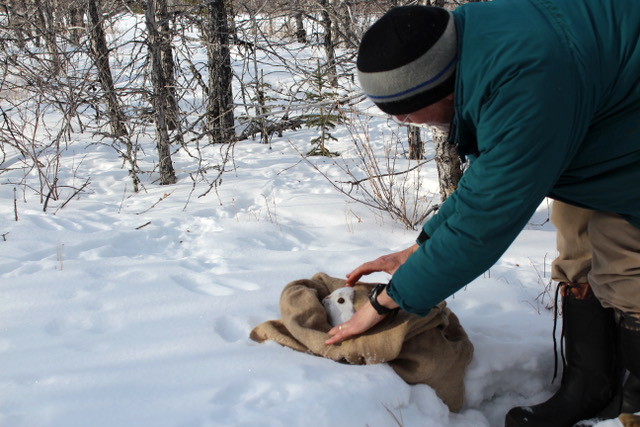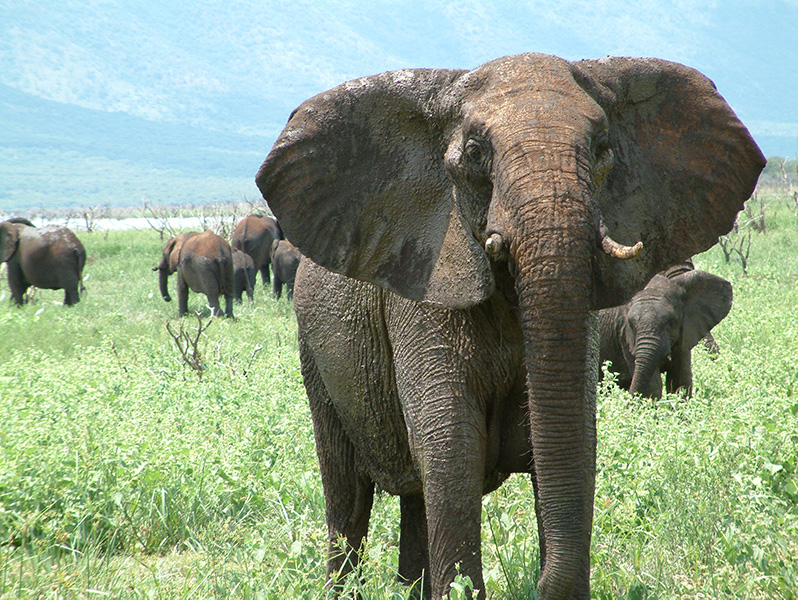Every few years, snowshoe hare numbers in the Canadian Yukon climb to a peak. As hare populations increase, so do those of their predators: lynx and coyotes. Then the hare population plummets and predators start to die off. The cycle is a famous phenomenon among ecologists and has been studied since the 1920s.
In recent years, though, researchers have come to a startling conclusion: Hare numbers fall from their peak not just because predators eat too many of them. There’s another factor, too: Chronic stress from living surrounded by killers causes mother hares to eat less food and bear fewer babies. The trauma of living through repeated predator chases triggers lasting changes in brain chemistry that parallel those seen in the brains of traumatized people. Those changes keep the hares from reproducing at normal levels, even after their predators have died off.

The brain circuitry responsible for fear and traumatic memories is shared by all mammals, including people. Many researchers now think that the roots of PTSD may lie in this shared circuitry and its evolved mechanisms to cope with danger.
CREDIT: IMAGEBROKER / ALAMY STOCK PHOTO
And it’s not just snowshoe hares, as behavioral ecologists Liana Zanette and Michael Clinchy have shown. Zanette and Clinchy, both at the University of Western Ontario, are a married couple who majored in psychology as undergraduates. Today, they study what they call the ecology of fear, which combines the psychology of trauma with the behavioral ecology of fear in wild animals. They’ve found that fear of predators can cause other wild mammals and songbirds to bear and raise fewer young. The offspring of frightened voles and song sparrows, like those of stressed snowshoe hares, are less likely to survive to adulthood and succeed in reproducing.
These findings add to a growing body of evidence showing that fearful experiences can have long-lasting effects on wildlife and suggesting that post-traumatic stress disorder, with its intrusive flashback memories, hypervigilance and anxiety, is part of an ancient, evolved response to danger. The work is part of a wider scientific debate over the nature of PTSD and whether it is an evolved response shared among mammals, birds and other creatures, or is unique to humans.
Lasting effects of trauma
Studies of the ecology of fear started in the 1990s. Before then, scientists assumed that the impact of a predator on an individual prey animal was either deadly or fleeting. If a hare survived a coyote attack, or a zebra escaped the claws of a lion, it would move on and live its life as before.
But research shows that fear can alter the long-term behavior and physiology of wild animals, from fish to elephants, Zanette and Clinchy write in the 2020 Annual Review of Ecology, Evolution, and Systematics. “Fear is a response all animals mount to avoid being killed by predators,” says Zanette. “It’s enormously beneficial, because it keeps you alive to breed another day. But it does carry costs.”
The reasons to fear are clear. Recent studies have found that up to 32 percent of adult female giraffes in the Serengeti carry scars from lion attacks, 25 percent of harbor porpoises in the southern North Sea have claw and bite marks from gray seals and 100 percent of manta rays in some African waters bear multiple bite wounds from sharks. These survivors may carry memories of terror along with their physical scars.
Rudy Boonstra, a population ecologist at the University of Toronto, has studied the impacts of extreme stress on the snowshoe hares and other small mammals of the Canadian Yukon since the 1970s. He was inspired by his own family history: Boonstra was born in the Netherlands, where his mother — like many of the Dutch — experienced severe stress during World War II. “That likely affected her children,” he says. “That sense of stress being a relevant factor in our biology was always in the back of my mind.”
Boonstra knew that during the decline phase of the snowshoe hare cycle, the great majority of hares are killed by predators. But there turned out to be more to the story. When Boonstra’s student, Michael Sheriff, tested feces of live-caught hares during the rise and fall phases of the population cycle, he found that levels of the stress hormone cortisol in mother hares fluctuated with predator density, peaking when predators were most numerous.

Researcher Rudy Boonstra releases a snowshoe hare after weighing, tagging and measuring it. Stress hormone levels in mother hares spike upward when predators are abundant, and they bear fewer, smaller young that also have heightened stress hormone levels. The effects of predation trauma thus last into succeeding generations, even after predators become scarcer.
CREDIT: COURTESY OF RUDY BOONSTRA
Those highly stressed mothers, the researchers found, bore fewer, smaller babies. And heightened stress hormone levels were also passed from mothers to daughters, slowing the rates of hare reproduction even after predators had died off and abundant vegetation was available for hares to eat. This explains why the hare population remains low for three to five years after predators have all but vanished from Boonstra’s study site.
Early pioneers of stress physiology focused on human problems and viewed such stress responses as pathological, but Boonstra has come to disagree. He sees the response of snowshoe hares as an adaptation that allows the animals to make the best of a bad situation. Animals stressed by many predators spend more time hiding and less time feeding, so they produce fewer young — but that may allow more adult hares to survive to rebuild the population when the cycle starts again.
Traumatized elephants
Some of the most dramatic impacts of wildlife trauma have been observed in African elephants. Their populations have declined drastically due to poaching, legal culling and habitat loss. Undisturbed elephants live in extended family groups ruled by matriarchs, with males departing when they reach puberty. Today, many surviving elephants have witnessed their mothers and aunts slaughtered before their eyes. A combination of early trauma and the lack of stable families that would ordinarily be anchored by elder elephants has resulted in orphaned elephants running amok as they grow into adolescence.
“There are interesting parallels between what we see in humans and elephants,” says Graeme Shannon, a behavioral ecologist at Bangor University in Wales who studies the African elephant. Trauma in childhood and the lack of a stable family are major risk factors for PTSD in people. And among elephants who’ve experienced trauma, Shannon notes, “we’re seeing a radical change in their development and their behavior as they mature.” Elephants can remain on high alert years after a terrifying experience, he says, and react with heightened aggression.
Shannon experienced this firsthand when he and his colleagues were following a herd of elephants in South Africa’s Pongola Game Reserve. The researchers kept their car at a respectful distance. But when they rounded a curve, Buga, the herd’s matriarch, stood blocking the road. The driver immediately turned off the engine, which generally causes elephants to move on peaceably. Instead, Buga charged the car. “Next thing we knew,” remembers Shannon, “the car was upside down and we were running.” Buga’s extreme reaction, he suspects, was linked to trauma she experienced when she was captured and relocated six years earlier.

Buga, the matriarch of an elephant herd in Pongola Game Reserve in South Africa, was once captured and relocated. Years later, lasting memories of this trauma may have prompted her to attack and flip a researcher’s car when it got too close.
CREDIT: PHOTO BY BRAD CARTER
Human responses to danger, injury and loss are likely part of this same evolved set of responses. A vast body of evidence shows that the brains of mice, men — in fact, all mammals and birds, fish, even some invertebrates — share a common basic structure, and common responses to terror or joy. The brain circuitry that signals fear and holds memories of terrifying events lies in the amygdala, a structure that evolved long before hominids with bulging forebrains came into being.
Most modern people with PTSD have been traumatized in combat or during a criminal attack or a car crash. But the intrusive memories of trauma, the constant state of alarm that can wear down the body’s defenses and lead to physical illness — these arise from the same ancient brain circuits that keep the snowshoe hare on the lookout for hungry lynx, or the giraffe alert for lions.
The amygdala creates emotional memories, and has an important connection to the hippocampus, which forms conscious memories of everyday events and stores them in different areas of the brain. People or other animals with damaged amygdalae can’t remember the feeling of fear, and so fail to avoid danger.
Brain imaging studies have shown that people with PTSD have less volume in their hippocampus, a sign that neurogenesis — the growth of new neurons — is impaired. Neurogenesis is essential to the process of forgetting, or putting memories into perspective. When this process is inhibited, the memory of trauma becomes engraved in the mind. This is why people with PTSD are haunted by vivid memories of an ordeal long after they’ve reached safety.
In a similar manner, fear of predators suppresses neurogenesis in lab rats. And Zanette and Clinchy are demonstrating that the same pattern holds in wild creatures living in their native habitats.
Neurogenesis, or the formation of new connections between brain cells, is crucial to an animal’s ability to forget and move on after a scare. Intense fear — especially when accompanied by physical trauma — suppresses neurogenesis and can lead to persistent memories that keep animals in a permanent state of fear that prevents them from feeding freely. This, in turn, can mean fewer offspring.
The scientists began by broadcasting the calls of hawks in a forest and found that nesting female song sparrows that heard the calls produced 40 percent fewer live offspring than those that did not. In later experiments, they showed that brown-headed cowbirds and black-capped chickadees that heard predator calls showed enduring neurochemical changes due to fear a full week later. The cowbirds had lowered levels of doublecortin, a marker for the birth of new neurons, in both the amygdala and hippocampus.
The same pattern has been shown in wild mice and in fish living with high levels of predator threat. These neurochemical signals parallel those seen in rodent models of PTSD that researchers have long used to understand the syndrome in humans.
Is PTSD uniquely human?
Despite the mounting evidence that a wide range of animals experience long-term impacts of extreme stress, many psychologists still see PTSD as a uniquely human problem. “PTSD is defined in terms of human responses,” says David Diamond, a neurobiologist at the University of South Florida. “There is no biological measure — you can’t get a blood test that says someone has PTSD. This is a psychological disease, and that’s why I call it a human disorder. Because a rat can’t tell you how it feels.”
Some researchers now disagree with this human-centric view of PTSD, however. “A lot of things are shared between humans and other mammals,” says Sarah Mathew, an evolutionary anthropologist at Arizona State University. This includes learning about and responding to danger, and avoiding situations that present life-threatening risks. Mathew believes that PTSD has deep evolutionary roots, and that some of its symptoms arise from adaptations — like a heightened state of alert — that allow individuals of many species, including our own, to manage danger.
This evolutionary perspective is beginning to change minds. Clinchy and Zanette have organized conferences on the ecology of fear and PTSD that bring together ecologists, psychiatrists and psychologists. “The psychiatrists and psychologists were talking about PTSD as maladaptive,” recalls Clinchy. “We were arguing that this is an adaptive behavior, to show these extreme reactions in this particular context, because that increases your survival.”
Diamond came to agree. The brain of someone with PTSD, he says, “is not a damaged or dysfunctional brain, but an overprotective brain. You’re talking about someone that has survived an attack on his or her life. So the hypervigilance, the inability to sleep, the persistent nightmares that cause the person to relive the trauma — this is part of an adaptive response gone awry.”
“There’s a stigma involved in PTSD, frequently,” says Zanette, “so people don’t seek treatment. But if patients can understand that their symptoms are perfectly normal, that there is an evolutionary function for their symptoms, this might relieve some of the stigma around it so that people might go and seek treatment.”




